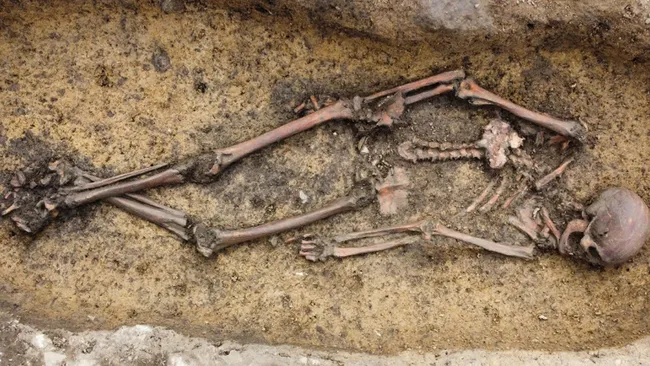50 Viking Age graves discovered in Denmark
- October 2, 2024
- 0
An extraordinary Viking burial containing the nearly complete skeletons of around 50 people has been unearthed in Denmark in preparation for the laying of electrical cables. The statement
An extraordinary Viking burial containing the nearly complete skeletons of around 50 people has been unearthed in Denmark in preparation for the laying of electrical cables. The statement

An extraordinary Viking burial containing the nearly complete skeletons of around 50 people has been unearthed in Denmark in preparation for the laying of electrical cables. The statement stated that the discoveries were made by archaeologists from the Odense Museum near the village of Osum on the island of Funen in the last six months.
It is rare to find any human remains from the Viking Age (793 – 1066 AD) as Scandinavian soils were acidic and did not preserve bones well. Therefore, the discovery of 50 burials from this period is extraordinary.
Michael Borre Lundo, an archaeologist working on the excavation and curator of the Odense Museum, said in a statement: “It is truly unusual to find such a well-preserved skeleton at the same time as those found in Osuma.” “This discovery opens up extraordinary opportunities for a wide range of scientific analyzes that could reveal more about general health, nutrition, and the origins of burials.”
“The analysis may even reveal whether the Viking graves are related to each other, which will be particularly important as similar graves have never been investigated before,” he added.
Viking Age burials near Osum date back to the 900s, possibly when Danish King Gorm “the Old” and Queen Thira ruled from the nearby Jutland city of Jelling. Historians differ on where Gorm ruled, but it is generally accepted that the central island of Funen was part of Gorm’s kingdom. According to archaeologists, the new finds testify to the importance of the region at that time.
Gorm and Tyra were the parents of Harald Bluetooth, who became king after Gorm’s death in about 958 and gave his name to the wireless networking standard. Harald claimed to have converted the Danes to Christianity. However, in the Viking kingdoms ruled by Gorm and Tyra, Old Norse gods such as Thor, Odin, and Freyr were worshiped.
Most of the people buried at Osuma were wealthy, as evidenced by their grave goods. For example, one tomb depicts a woman buried in a distinctive cradle-like bed in a Viking wagon.
“The woman was probably buried in the car in which she was traveling,” Borre Lundyo said. “She was presented with a beautiful necklace of glass beads, an iron key, a knife with a silver handle and, most importantly, a small piece of glass that may have served as an amulet.”
According to him, there was also a beautifully decorated wooden chest in the grave, the contents of which are not yet known.
In another grave, in addition to the three-pronged bronze buckle hung around the neck of the deceased, there is also a red glass bead; iron knife; and a small piece of rock crystal.
“The rock crystal does not occur naturally in Denmark, it was probably imported from Norway,” Borre Lunde said. he said. “A variety of objects recovered from many graves at Osuma indicate that Viking graves were linked to international trade networks that developed during the Viking Age.”
Source: Port Altele
As an experienced journalist and author, Mary has been reporting on the latest news and trends for over 5 years. With a passion for uncovering the stories behind the headlines, Mary has earned a reputation as a trusted voice in the world of journalism. Her writing style is insightful, engaging and thought-provoking, as she takes a deep dive into the most pressing issues of our time.